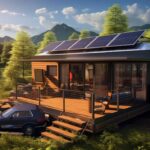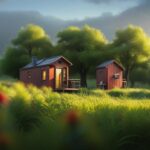Tiny Houses
How Can We Build and Sell a Tiny House

I have always been intrigued by the concept of constructing and selling small houses. The idea of designing a comfortable, eco-friendly home that can bring joy to others excites me.
In this article, I’ll guide you through the process of planning, designing, and constructing a tiny house. We’ll explore sourcing the right materials, implementing smart space-saving solutions, and even delve into marketing strategies to help you sell your creation.
Get ready to embark on a journey of creativity and entrepreneurship in the world of tiny homes.
Key Takeaways
- Incorporate space-saving furniture, multi-functional pieces, and fold-down tables to optimize available space.
- Maximize storage with hidden compartments, built-in storage solutions, and convertible furniture.
- Utilize vertical space effectively with taller cabinets, shelving units, shelves, and hooks.
- Prioritize durability, sustainability, and eco-friendly materials in the sourcing and selection process.
Planning and Designing Your Tiny House
I’m excited to start planning and designing my tiny house. As I begin this process, I understand the importance of incorporating space-saving furniture and off-grid living options.
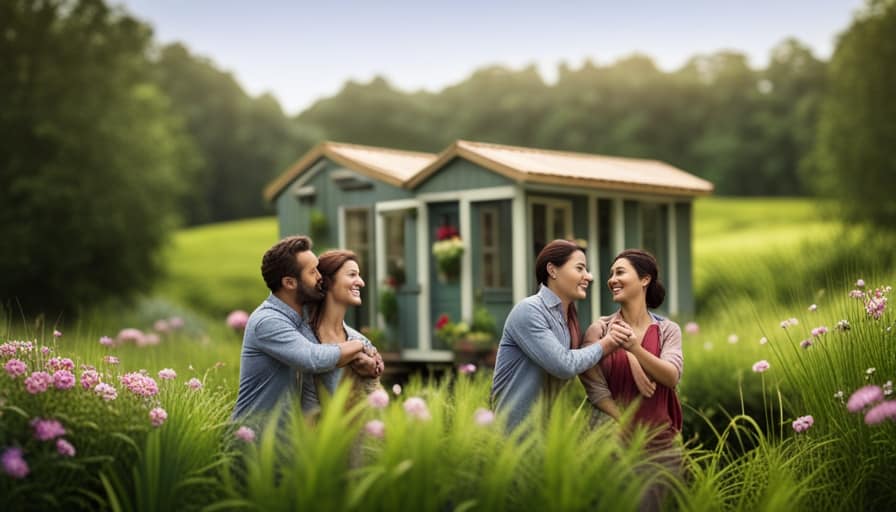
Space-saving furniture is essential in maximizing the limited area of a tiny house. Multi-functional pieces, such as convertible beds, fold-down tables, and hidden storage compartments, can help optimize the available space.
Additionally, off-grid living options are vital for sustainable and self-sufficient living. This includes installing solar panels for electricity, composting toilets, and rainwater harvesting systems. These solutions not only reduce our environmental impact but also provide independence from traditional utility systems.
Sourcing and Selecting the Right Materials
When sourcing and selecting the right materials, I’ll prioritize durability and sustainability for my tiny house project. It’s important to choose materials that will withstand the test of time and minimize the environmental impact.
For the structure, I’ll consider using eco-friendly options such as reclaimed wood or sustainable bamboo. These materials not only offer strength and durability but also contribute to reducing deforestation.
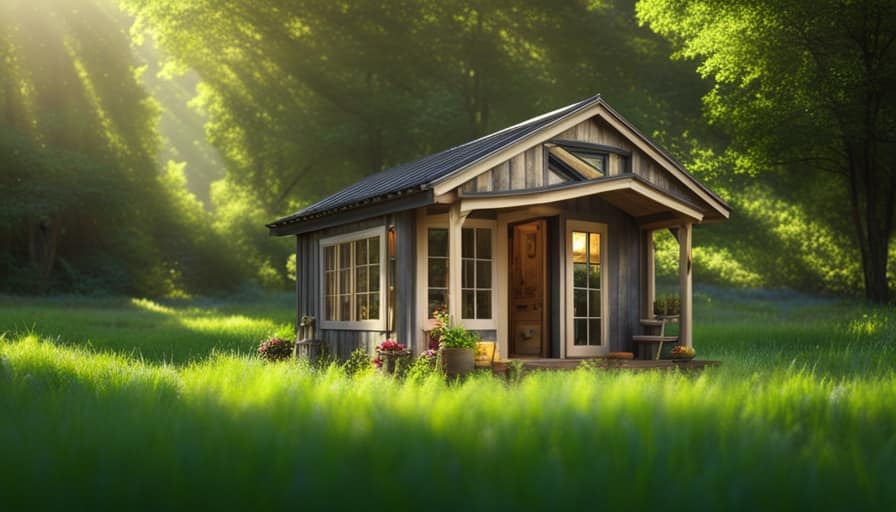
Additionally, I’ll explore budget-friendly alternatives like recycled steel or concrete blocks for the foundation. These materials provide stability and longevity while being cost-effective.
For insulation, I’ll opt for natural options like sheep’s wool or cellulose insulation, which not only provide excellent thermal performance but also have minimal impact on the environment.
Construction Tips and Techniques for Tiny Homes
One important construction tip for tiny homes is to maximize space by utilizing multifunctional furniture and storage solutions. This not only helps to optimize the limited square footage but also adds functionality to the living space. Here are some interior design ideas to consider for tiny house construction:
-
Incorporate built-in storage: Utilize every nook and cranny by incorporating built-in storage solutions such as under-bed drawers, wall-mounted shelves, and hidden compartments.
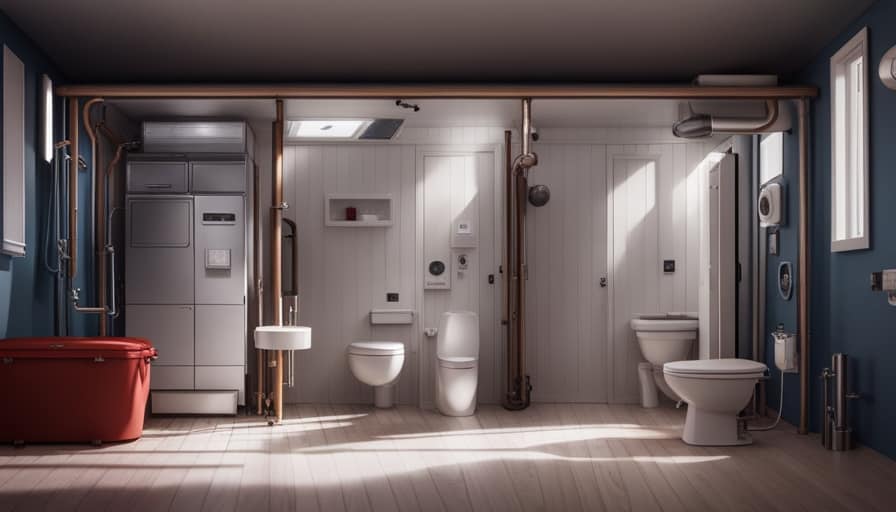
-
Choose convertible furniture: Invest in furniture pieces that can serve multiple purposes, such as a sofa that can be transformed into a bed, or a dining table that can be folded down when not in use.
-
Utilize vertical space: Make use of vertical space by installing taller cabinets, shelving units, and even hanging storage solutions.
Maximizing Space and Storage Solutions
Utilizing creative storage solutions is key to maximizing space in a tiny house. In order to make the most of every square inch, it’s important to incorporate space-saving furniture and creative organization ideas.
One option is to invest in multi-functional furniture, such as a sofa that can also be used as a bed, or a table that can be folded down when not in use.

Another idea is to use vertical space effectively, by installing shelves and hooks on walls to store items.
Additionally, utilizing hidden storage compartments, such as under-bed storage or built-in cabinets, can help keep the space organized and clutter-free.
Marketing and Selling Your Tiny House
To successfully market and sell my tiny house, I’ll need to create an effective advertising strategy and utilize various selling platforms. Here are three key strategies that will help me reach my target market and increase the chances of selling my tiny house:
-
Identify my target market: Before I can sell my tiny house, I need to understand who my ideal buyer is. This involves researching demographics, interests, and lifestyles of potential buyers to tailor my marketing efforts accordingly.
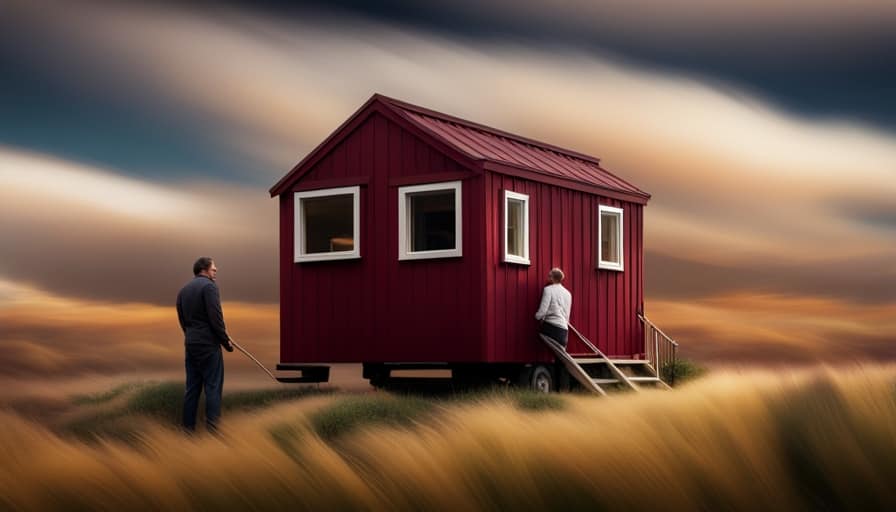
-
Showcase the unique features: To stand out in a competitive market, I need to highlight the unique aspects of my tiny house. Whether it’s the eco-friendly design or the innovative space-saving solutions, showcasing these features will attract the attention of potential buyers.
-
Utilize online platforms: In today’s digital age, online platforms are essential for reaching a wider audience. I’ll utilize websites, social media platforms, and online marketplaces to advertise and promote my tiny house effectively.
Frequently Asked Questions
How Much Does It Cost to Build a Tiny House?
Building a tiny house involves careful cost estimation and considering financing options. It’s important to research the materials, labor, and permits required. With proper planning, the cost of building a tiny house can be minimized.
What Are the Legal Requirements for Living in a Tiny House?
To navigate the legal requirements for living in a tiny house, it is crucial to understand the zoning restrictions in your area. These regulations dictate where and how you can legally reside in a tiny home.

Are There Any Specific Building Codes or Regulations for Tiny Houses?
When it comes to building and selling a tiny house, it’s important to be aware of zoning restrictions and permits. These regulations ensure compliance with local laws and help maintain safety standards for the community.
How Long Does It Typically Take to Build a Tiny House?
Typically, it takes several weeks to several months to build a tiny house, depending on the complexity and size. The timeline can be affected by factors such as availability of construction materials and the skills of the builders.
What Are Some Common Challenges People Face When Building a Tiny House?
When building a tiny house, people often face challenges such as limited space, zoning regulations, and finding cost-effective materials. However, with cost-saving tips and practical design ideas, these challenges can be overcome to create a functional and affordable tiny home.
Conclusion
In conclusion, building and selling a tiny house requires careful planning, meticulous sourcing of materials, and skillful construction techniques. Maximizing space and storage solutions is crucial for attracting potential buyers.
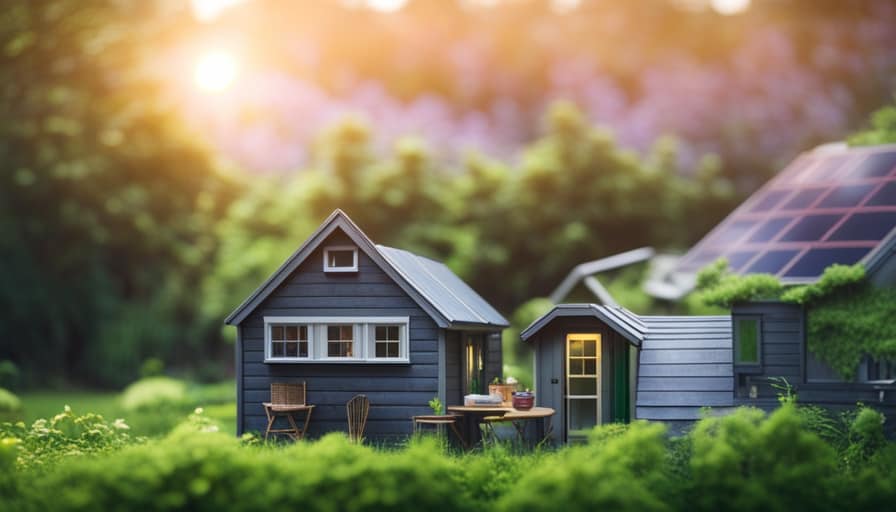
However, let’s not forget the importance of marketing in this process. With a touch of creativity and a sprinkle of satire, you can make your tiny house stand out from the crowd and appeal to the adventurous souls seeking a unique and sustainable living experience.
Happy selling!
I’m Theodore, and I love tiny houses. In fact, I’m the author of Tiny House 43, a book about tiny houses that are also tree houses. I think they’re magical places where imaginations can run wild and adventures are just waiting to happen.
While tree houses are often associated with childhood, they can be the perfect adult retreat. They offer a cozy space to relax and unwind, surrounded by nature. And since they’re typically built on stilts or raised platforms, they offer stunning views that traditional homes simply can’t match.
If you’re looking for a unique and romantic getaway, a tree house tiny house might just be the perfect option.
Tiny Houses
How Do You Hook up a Tiny House to Electric, Water, and Sewer

Congratulations on your decision to take on the adventure of living in a tiny house!
Now, let’s talk about the practical side of things: how do you hook up your tiny house to electric, water, and sewer?
In this article, we’ll explore the step-by-step process of connecting your tiny house to these essential utilities, ensuring safety, efficiency, and peace of mind.
From understanding electric connections to exploring sewer options, we’ve got you covered.

Let’s get started!
Key Takeaways
- Compliance with electrical codes is crucial for safety and hazard prevention.
- Proper wiring, circuit connection, and grounding are important for safety.
- Install a separate electrical panel dedicated to the tiny house.
- Ensure all connections are secure and leak-free.
Understanding Electric Connections
Before I can explain how to hook up a tiny house to electric, water, and sewer, it’s important to understand the basics of electric connections.
When it comes to electric panel installation, there are a few key factors to consider. First and foremost, it’s crucial to ensure compliance with electrical codes. These codes are in place to prioritize safety and prevent hazards. You need to be familiar with the specific requirements of your locality and adhere to them strictly.
Additionally, it’s crucial to have a clear understanding of the electric panel installation process. This includes knowing how to properly wire the panel, connect circuits, and ensure proper grounding.
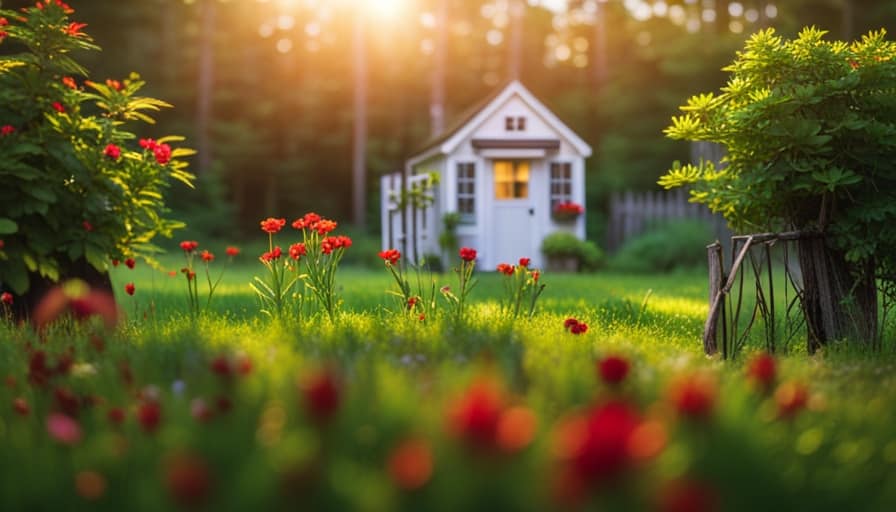
Connecting to a Water Source
To properly connect my tiny house to a water source, I’ll need to use a combination of hoses and pipes, as well as a water pressure regulator to ensure a steady flow of water. Here are the steps I’ll take to connect my tiny house to a water source:
-
First, I’ll attach a hose to the water source using a standard hose connector.
-
To ensure clean and safe water, I’ll install a water filtration system. This system will remove impurities and improve the quality of the water.
-
If I want to conserve water and reduce my environmental impact, I can also consider rainwater harvesting. This involves collecting rainwater from the roof of the tiny house and storing it in a tank for later use.
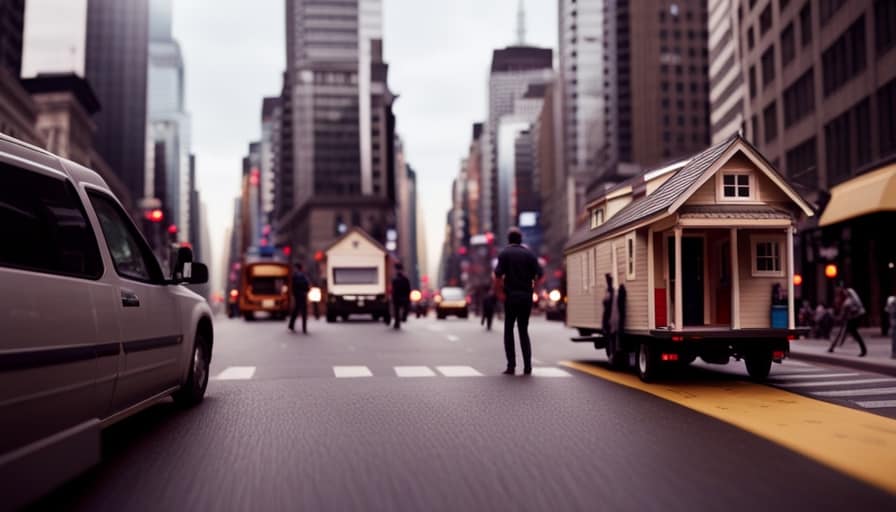
-
Finally, I’ll connect the water supply hose to the tiny house’s plumbing system, ensuring that all connections are secure and leak-free.
By following these steps, I can ensure a reliable and sustainable water supply for my tiny house.
Now, let’s explore the options for connecting the sewer system.
Exploring Sewer Connection Options
One option I’ve for connecting my tiny house to the sewer system is by using a standard sewer hose and a sewer connection adapter. This method involves connecting the hose to the sewer outlet of my tiny house and then attaching the other end to the sewer connection adapter, which is then connected to the main sewer line. This allows for a simple and effective way of disposing of waste from my tiny house.

However, it’s important to note that there are other sewer connection alternatives available, such as composting toilets or septic systems. It’s crucial to consider local regulations and finding suitable water sources for these alternatives to ensure compliance and proper waste management in my tiny house.
Ensuring Safety With Electrical Hookups
I must prioritize the safety of my tiny house by ensuring proper electrical hookups. To avoid common electrical hookup mistakes and comply with electrical hookup regulations, here are four essential steps to follow:
-
Consult with a licensed electrician: Seek the expertise of a professional who can assess your electrical needs and provide guidance on the appropriate hookup options for your tiny house.
-
Install a separate electrical panel: To ensure safety and efficiency, it’s crucial to have a separate electrical panel specifically dedicated to your tiny house. This will prevent overloading and allow for easier troubleshooting.
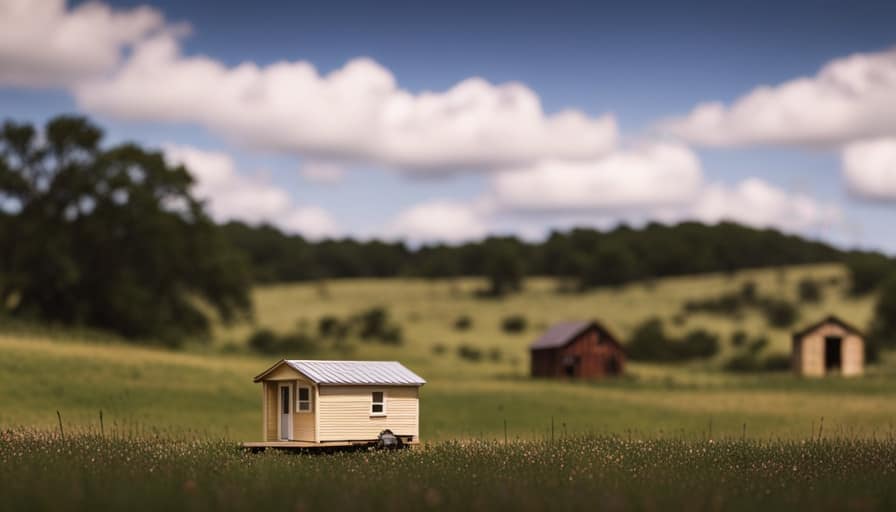
-
Use the correct gauge wire: Selecting the proper gauge wire is crucial to prevent overheating and potential fire hazards. Consult with an electrician to determine the appropriate wire size for your electrical needs.
-
Install ground fault circuit interrupter (GFCI) outlets: GFCI outlets are designed to protect against electrical shock and should be installed in all areas where water is present, such as the kitchen and bathroom.
Maximizing Efficiency in Water and Sewer Systems
I frequently strive to maximize efficiency in my water and sewer systems to ensure optimal usage and minimal waste. One of the most effective water conservation strategies I employ is installing low-flow fixtures such as faucets, showerheads, and toilets. These fixtures reduce water consumption without compromising functionality.
Additionally, I utilize alternative energy sources to power my water and sewer systems. Solar panels are a great option for generating electricity to operate pumps and filtration systems.
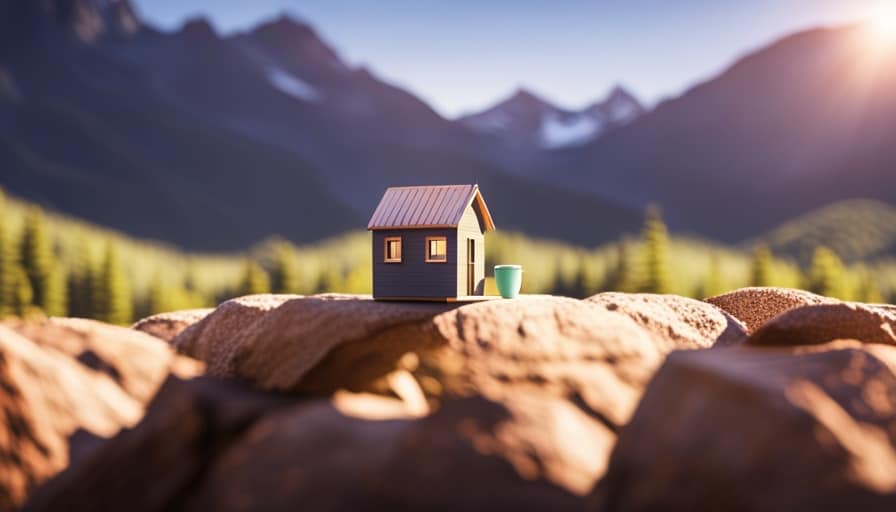
Rainwater harvesting is another technique I implement to conserve water. By collecting rainwater in barrels or underground tanks, I can use it for non-potable purposes such as watering plants or flushing toilets.
These water conservation strategies, coupled with the use of alternative energy sources, allow me to maximize efficiency in my water and sewer systems while minimizing my environmental impact.
Frequently Asked Questions
Can I Hook up My Tiny House to Solar Power Instead of Relying on the Electrical Grid?
I can hook up my tiny house to solar power instead of relying on the electrical grid. Solar power provides energy efficiency and has both pros and cons. It is a reliable and renewable energy source, but initial costs and limited power storage may be challenges.
What Are the Regulations and Permits Required for Hooking up a Tiny House to Public Water and Sewer Systems?
Regulations and permits for connecting a tiny house to public water and sewer systems vary by location. It’s crucial to research local guidelines and obtain necessary approvals. Financing options for tiny houses can also be explored.
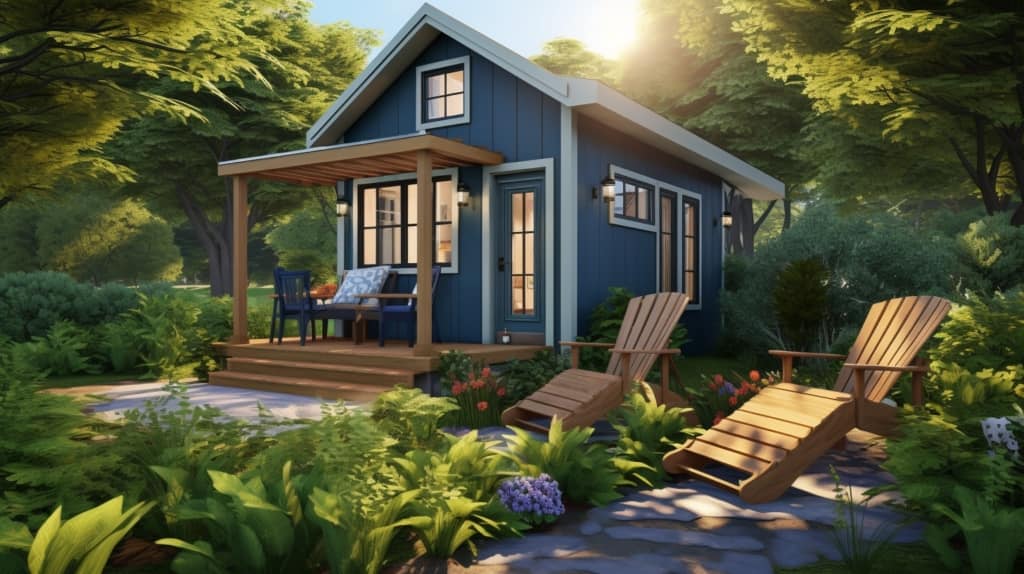
How Do I Determine the Right Size Water Heater for My Tiny House?
To determine the right size water heater for a tiny house, I calculate my water usage by considering the number of occupants and their daily needs. Choosing energy-efficient appliances helps minimize utility costs.
Are There Any Specific Building Codes or Regulations I Need to Consider When Connecting My Tiny House to Electric, Water, and Sewer?
When connecting a tiny house to electric, water, and sewer, it is important to consider building code regulations. These regulations ensure safety and compliance. Additionally, there may be cost implications associated with meeting these requirements.
Is It Possible to Use Composting Toilets or Other Alternative Waste Management Systems in a Tiny House?
Using composting toilets or alternative waste management systems in a tiny house offers several benefits. They reduce water usage, provide sustainable waste disposal, and eliminate the need for a traditional sewer hookup.
Conclusion
In conclusion, connecting a tiny house to electric, water, and sewer systems requires careful planning and consideration.
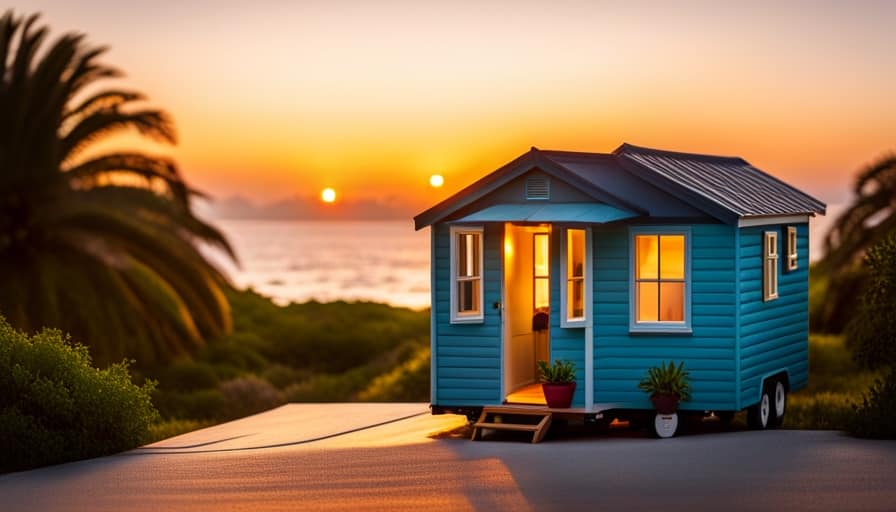
By understanding the electric connections, exploring water source options, and exploring sewer connection options, you can ensure a safe and efficient setup.
For example, in a case study, a tiny house owner in a remote location utilized solar panels for electricity, collected rainwater for their water source, and installed a composting toilet for their sewer system, allowing them to live sustainably off the grid.
I’m Theodore, and I love tiny houses. In fact, I’m the author of Tiny House 43, a book about tiny houses that are also tree houses. I think they’re magical places where imaginations can run wild and adventures are just waiting to happen.
While tree houses are often associated with childhood, they can be the perfect adult retreat. They offer a cozy space to relax and unwind, surrounded by nature. And since they’re typically built on stilts or raised platforms, they offer stunning views that traditional homes simply can’t match.
If you’re looking for a unique and romantic getaway, a tree house tiny house might just be the perfect option.
Tiny Houses
How Do You Heat and Cool a Travel Trailer or Tiny House

As a traveler or owner of a tiny house, it is crucial to find the most effective way to heat and cool your compact living space. But don’t worry, I’ve got you covered!
In this article, I’ll guide you through the ins and outs of heating options and cooling methods for travel trailers and tiny houses.
We’ll explore the pros and cons of electric heating systems and delve into alternative solutions for small homes.
So, let’s dive in and discover efficient ways to keep your cozy abode at the perfect temperature.

Key Takeaways
- There are various heating options available for travel trailers and tiny houses, including solar powered heating, propane heating, electric heating, and wood burning stoves.
- Cooling methods for travel trailers and tiny houses include portable air conditioners, window fans, and combination units with cooling and heating functions.
- Alternative heating solutions such as solar powered heating and wood burning stoves can provide sustainability and efficiency.
- Efficient cooling strategies involve using energy-efficient air conditioning units, proper insulation and ventilation, shading devices to reduce heat gain, and regular maintenance of cooling systems.
Heating Options for Travel Trailers and Tiny Houses
I’ll explore the various heating options available for travel trailers and tiny houses.
When it comes to keeping your space warm, there are two main options to consider: solar powered heating solutions and propane heating options.
Solar powered heating solutions are an excellent choice for those who want to minimize their carbon footprint and rely on renewable energy sources. These systems use solar panels to harness the power of the sun and convert it into heat, which is then distributed throughout the trailer or tiny house.
On the other hand, propane heating options offer a reliable and efficient way to heat your space. Propane heaters are easy to install and provide instant warmth. They’re also a great backup option for those times when sunlight isn’t sufficient to power the solar system.

Whether you choose solar or propane, both options provide effective heating solutions for your travel trailer or tiny house.
Cooling Methods for Compact Living Spaces
To keep my compact living space cool, I’ll explore the different cooling methods available. Here are three options to consider:
-
Portable Air Conditioners: These compact units are designed to cool small spaces efficiently. They come with adjustable settings and can be easily moved from one room to another. Portable air conditioners are perfect for cooling compact living spaces like travel trailers or tiny houses.
-
Window Fans: Window fans are a cost-effective cooling solution that can provide excellent ventilation. They can be easily mounted on a window and work by pulling in cool air from outside or pushing out warm air from inside. Window fans are energy-efficient and can effectively circulate air in your compact living space.
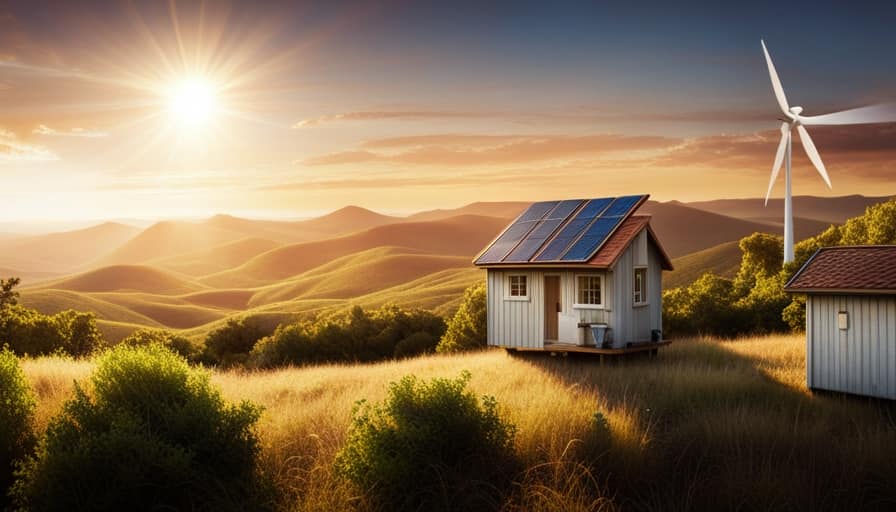
-
Combination Units: Some appliances offer both cooling and heating functions in one unit. These combination units are versatile and can be used year-round. They usually come with adjustable temperature settings and can be easily installed in compact living spaces.
Considering these cooling methods will help you keep your compact living space comfortable and cool.
Pros and Cons of Electric Heating Systems
One of the main advantages of electric heating systems is their ability to provide consistent warmth throughout my compact living space. These systems use electrical energy to generate heat, which is then distributed evenly throughout the area. This ensures that every corner of my trailer or tiny house is kept warm and comfortable, even during the coldest winter months.
However, like any heating system, electric heating systems also have their disadvantages. One major drawback is their reliance on electricity. This means that if there’s a power outage or if I’m off-grid, I won’t have access to heating unless I’ve a backup generator or alternative power source. Additionally, electric heating systems can be more expensive to operate compared to other heating options, such as propane or wood-burning stoves.
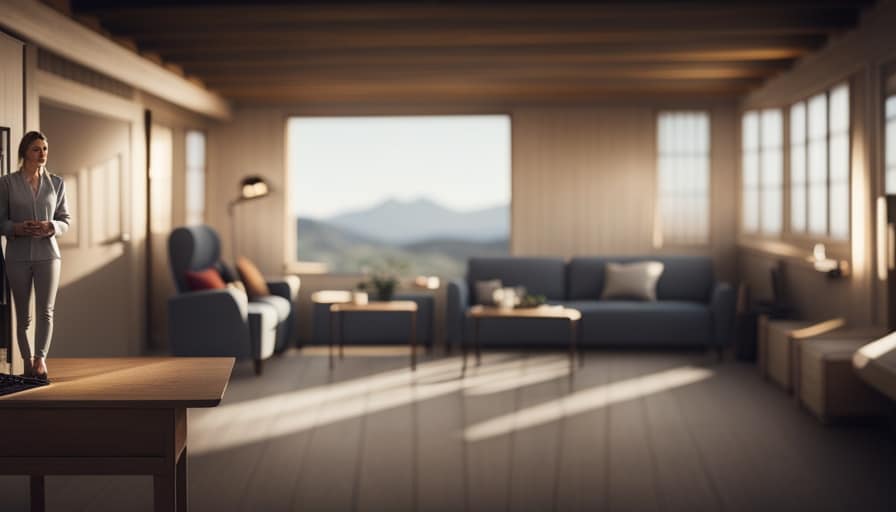
Despite these drawbacks, electric heating systems are still a popular choice for many small homeowners due to their convenience and ease of use. However, it’s important to explore alternative heating solutions for small homes that can provide warmth even in the absence of electricity.
Exploring Alternative Heating Solutions for Small Homes
When it comes to heating my small home, I’ve found that exploring alternative solutions can be a game-changer. Here are three options worth considering:
-
Solar powered heating solutions: Harnessing the power of the sun can provide a sustainable and cost-effective heating source for small homes. Solar panels can capture sunlight and convert it into usable heat energy, which can be used to heat water or air.
-
Wood burning stoves for small spaces: Wood burning stoves are a popular choice for small homes due to their compact size and efficient heat output. These stoves can burn wood pellets or logs to generate heat, making them a reliable and environmentally friendly option.

-
Radiant floor heating: This innovative heating system involves installing pipes or electric heating elements beneath the floor, which radiate heat upwards to warm the space. Radiant floor heating offers even heat distribution, increased energy efficiency, and reduced allergens.
These alternative heating solutions can provide warmth and comfort while minimizing energy consumption and environmental impact.
Efficient Cooling Strategies for Travel Trailers and Tiny Houses
Although it may be challenging to keep a travel trailer or tiny house cool, there are efficient strategies that can help maintain a comfortable temperature inside.
One option is to use portable AC units, which are compact and easy to install. These units can be placed in strategic locations to provide targeted cooling in specific areas of the trailer or tiny house.
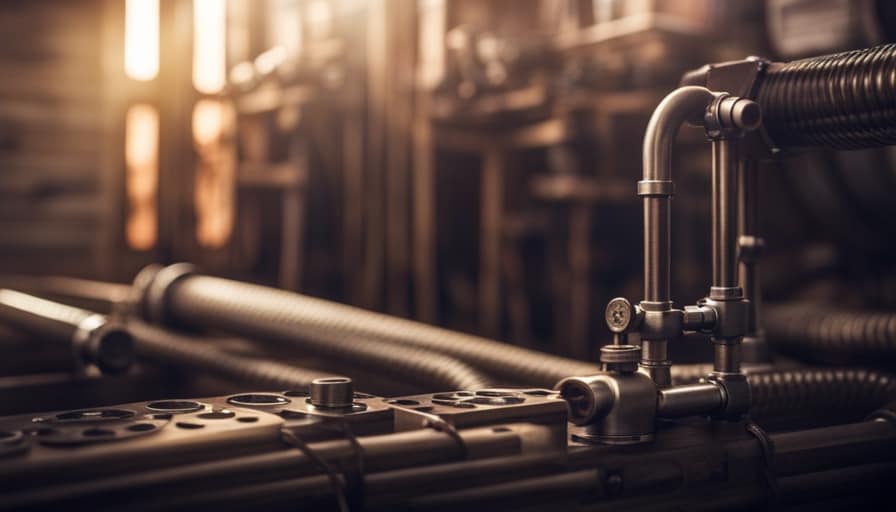
Another option is to implement passive cooling techniques, which rely on natural airflow and insulation to keep the interior cool. This can include features such as reflective roofing materials, insulation in the walls and ceiling, and strategically placed windows and vents to promote cross ventilation.
Frequently Asked Questions
What Are Some Safety Considerations When Using Electric Heating Systems in Small Homes?
When using electric heating systems in small homes, it is important to consider safety measures. Fire prevention is crucial, so make sure to keep flammable objects away from heaters and use proper ventilation.
Can I Use a Portable Heater to Heat My Travel Trailer or Tiny House?
Yes, you can use a portable heater to heat your travel trailer or tiny house. There are various options available, such as electric, propane, or diesel heaters, which are effective heating methods for small spaces.
Are There Any Cost-Effective Alternative Heating Solutions for Small Homes?
There are cost-effective heating options and energy-efficient cooling methods available for small homes. By exploring alternative solutions, you can find efficient ways to heat and cool your travel trailer or tiny house without breaking the bank.

How Can I Effectively Cool a Travel Trailer or Tiny House Without Using an Air Conditioner?
How can I effectively cool a travel trailer or tiny house without using an air conditioner? Are there alternative cooling methods or energy efficient cooling options available?
What Are the Potential Drawbacks of Using a Propane Heater for Heating a Compact Living Space?
Using a propane heater in a small living space can have potential hazards. It is important to ensure proper ventilation to prevent carbon monoxide buildup. Additionally, propane may not be as energy efficient as other heating options.
Conclusion
In conclusion, when it comes to heating and cooling travel trailers or tiny houses, there are various options to consider.
Electric heating systems, although convenient, may come with higher energy costs.

Exploring alternative heating solutions, such as propane or wood stoves, can be more efficient and cost-effective.
Additionally, efficient cooling strategies, like using reflective window coverings or installing ceiling fans, can help maintain a comfortable living space.
It’s important to find the right balance between functionality and energy efficiency to create a cozy and sustainable home on wheels.
I’m Theodore, and I love tiny houses. In fact, I’m the author of Tiny House 43, a book about tiny houses that are also tree houses. I think they’re magical places where imaginations can run wild and adventures are just waiting to happen.
While tree houses are often associated with childhood, they can be the perfect adult retreat. They offer a cozy space to relax and unwind, surrounded by nature. And since they’re typically built on stilts or raised platforms, they offer stunning views that traditional homes simply can’t match.
If you’re looking for a unique and romantic getaway, a tree house tiny house might just be the perfect option.
Tiny Houses
How Do You Hook up a Tiny House

Congratulations on deciding to join the tiny house movement! Now comes the exciting part of hooking up your tiny house. Don’t worry, I’ve got you covered.
In this article, I’ll walk you through the process of connecting your tiny home to water, electricity, and sewage systems. From choosing the right foundation to navigating zoning codes, I’ll share all the practical tips you need to make your tiny house dreams a reality.
Let’s dive in and get you hooked up!
Key Takeaways
- Connecting a tiny house to a reliable water source and installing a water pump and filtration system are essential for accessing clean water.
- Solar power is a renewable energy option that can be used to generate electricity for a tiny house, and installing solar panels on the roof can provide a reliable and eco-friendly source of electricity.
- Investing in a battery system allows for the storage of excess energy from solar panels, ensuring a continuous power supply during cloudy days or at night.
- When it comes to sewage and plumbing systems, it is important to plan and install necessary components, consult professionals for septic tank installation, and consider eco-friendly alternatives such as composting toilets. Regular maintenance and proper odor control are also vital for these systems.
Understanding the Utilities: Water and Electricity Connections
I’ll explain how I can hook up water and electricity connections for my tiny house.

Understanding propane usage and exploring solar power options are essential for a self-sufficient and sustainable living.
When it comes to water, I plan to connect my tiny house to a reliable water source, such as a well or a municipal water supply. I’ll install a water pump and a filtration system to ensure clean and safe water for everyday use.
As for electricity, I’m considering solar power as a renewable energy option. Installing solar panels on the roof of my tiny house will provide me with a reliable and eco-friendly source of electricity. I’ll also invest in a battery system to store excess energy for use during cloudy days or at night.
Ensuring Proper Sewage and Plumbing Systems
To effectively ensure proper sewage and plumbing systems in my tiny house, it is crucial to carefully plan and install the necessary components. One option for sewage disposal is the installation of a septic tank. It is important to consult with local authorities and professionals to determine the appropriate size and location for the tank. Additionally, consider the use of a composting toilet, which can be a sustainable and eco-friendly alternative. Composting toilets do not require water or plumbing connections and instead use natural decomposition processes to turn waste into compost. This option may require regular maintenance and proper ventilation to control odors. Overall, choosing the right sewage and plumbing systems for your tiny house requires thoughtful consideration of your needs, local regulations, and sustainable options.

| Key Considerations | Septic Tank Installation | Composting Toilet Options |
|---|---|---|
| Size and Location | Consult professionals and local authorities to determine the appropriate size and location for the septic tank. | Composting toilets do not require plumbing connections and can be installed in various locations within the tiny house. |
| Maintenance | Regular maintenance and pumping may be required to ensure the proper functioning of the septic tank. | Composting toilets require regular maintenance to manage decomposition and control odors. |
| Eco-Friendliness | Septic tanks can be environmentally friendly if properly sized and maintained. | Composting toilets are a sustainable option that helps reduce water consumption and waste. |
Choosing the Right Foundation for Your Tiny House
When choosing the right foundation for my tiny house, it’s important to consider factors such as soil type, local building codes, and personal preferences. The foundation plays a crucial role in providing stability and support for the structure.
There are several options to choose from, including concrete slabs, skids, and pier foundations. Concrete slabs are a popular choice as they provide a solid and durable base. Skids, on the other hand, are more portable and can be easily moved if needed. Pier foundations are ideal for uneven or sloping terrain.
Additionally, when considering insulation for my tiny house, I need to choose the right type that suits my needs and climate. For off-grid setups, it’s important to consider energy-efficient insulation to minimize heat loss and reduce energy consumption.
Navigating Zoning and Building Codes for Hooking Up
To successfully navigate zoning and building codes for hooking up a tiny house, it’s important to research and understand the specific regulations and requirements in your area.

Navigating permitting requirements is a crucial step in ensuring that you can legally hook up your tiny house. Contact your local zoning office or building department to inquire about the necessary permits and inspections needed for your project. They’ll be able to provide you with the specific guidelines and procedures to follow.
Additionally, finding suitable land for hooking up your tiny house is another important consideration. Look for properties that allow for accessory dwelling units or have flexible zoning regulations. It’s also essential to consider access to utilities such as water, electricity, and sewage.
DIY Vs. Professional Help: Pros and Cons of Hiring a Hookup Service
Why should I consider hiring a hookup service instead of doing it myself?
Hiring a professional hookup service for your tiny house installation can save you time, money, and potential headaches. Here are some key considerations:
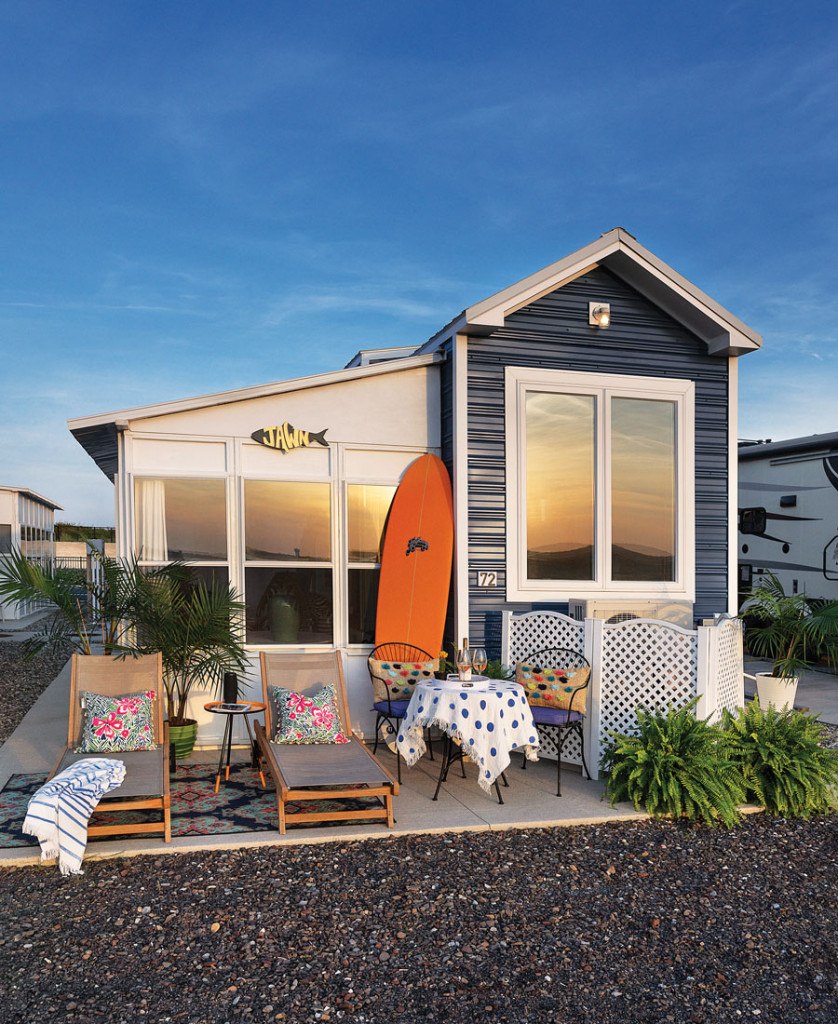
-
Expertise: Professionals have the knowledge and experience to handle the complexities of tiny house hookups, ensuring everything is done correctly.
-
Efficiency: Hooking up a tiny house involves various systems, such as plumbing, electrical, and HVAC. Professionals can efficiently handle all these aspects, reducing the risk of mistakes and delays.
-
Compliance: Local building codes and regulations may require specific permits and inspections. A professional hookup service will be familiar with these requirements, ensuring your installation meets all necessary standards.
While DIY installations may seem cost-effective initially, mistakes or improper installations can lead to expensive repairs down the line. By hiring a professional hookup service, you can have peace of mind knowing the job will be done right the first time, saving you time, money, and potential headaches.
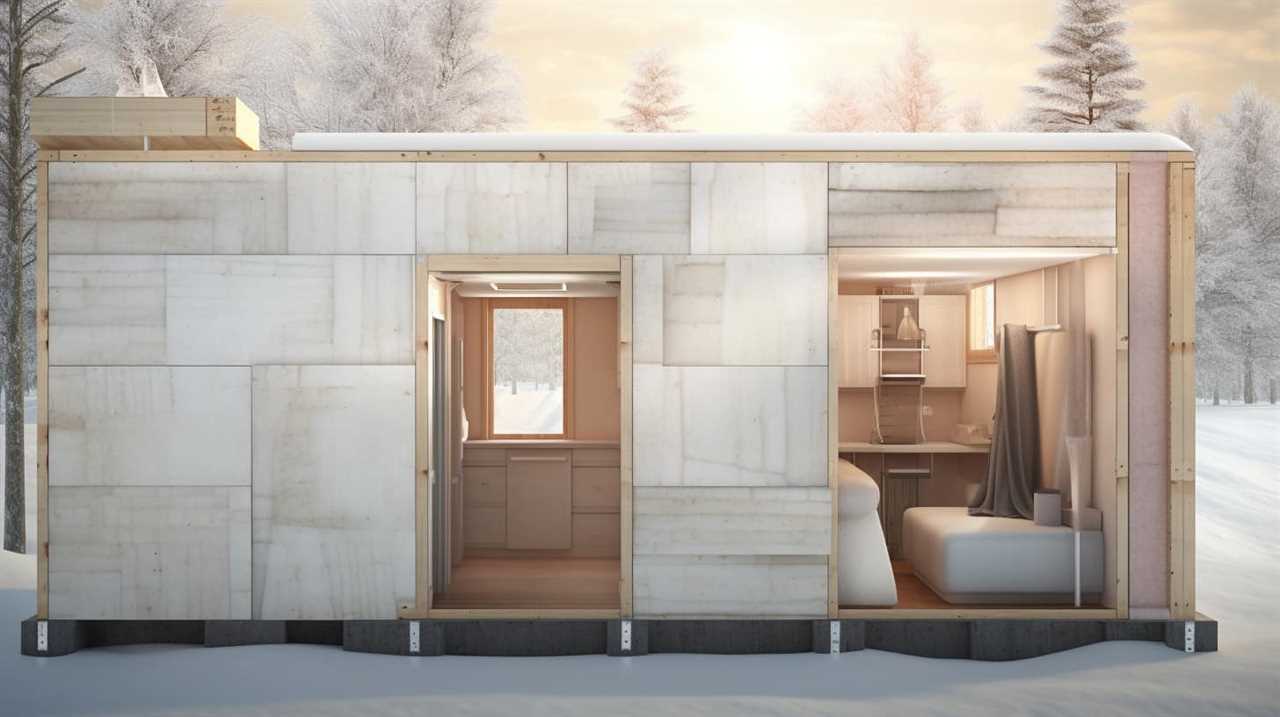
Frequently Asked Questions
What Are the Different Types of Water and Electricity Connections Available for a Tiny House?
There are several types of water and electricity connections available for a tiny house. It’s important to know how to safely connect them. Let me explain the different options and how to hook them up.
How Can I Ensure That My Sewage and Plumbing Systems Are up to Code for a Tiny House?
To ensure my sewage and plumbing systems are up to code for a tiny house, I’ll research local regulations and consult with a licensed plumber. Following these guidelines will help me maintain compliance and ensure a properly functioning system.
What Are the Factors to Consider When Choosing the Right Foundation for a Tiny House?
When choosing the right foundation for a tiny house, there are several factors to consider. These include soil conditions, local building codes, cost, and ease of installation. Different types of foundations have their pros and cons.
What Are the Common Zoning and Building Codes I Need to Be Aware of When Hooking up My Tiny House?
Zoning regulations and building permits are crucial when hooking up a tiny house. It’s important to research and comply with local codes to ensure a smooth and legal process.
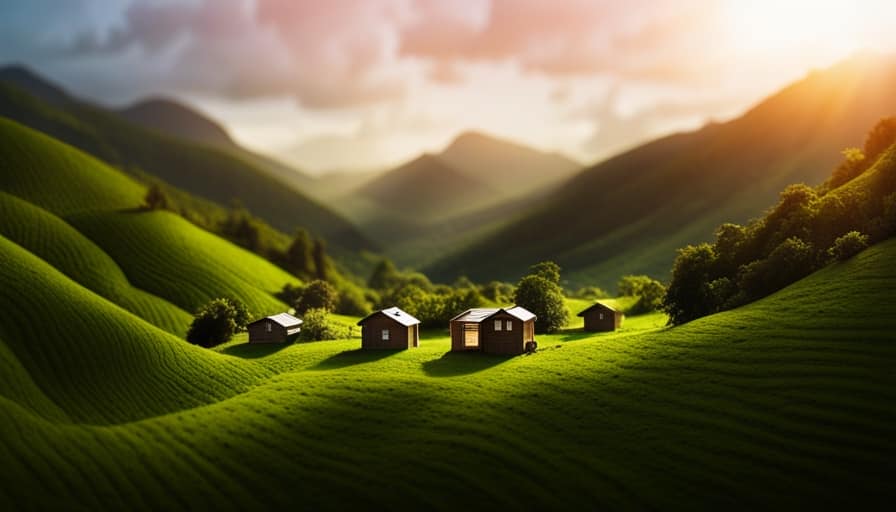
What Are the Pros and Cons of Hiring a Professional Hookup Service for My Tiny House?
Should I hire a professional or DIY my tiny house hookup? Hiring a professional hookup service for your tiny house has pros and cons. The pros include expertise and peace of mind, while the cons include cost and potential delays.
Conclusion
In conclusion, hooking up a tiny house requires careful consideration and planning.
One interesting statistic to consider is that according to a survey conducted by Tiny House Community, over 75% of tiny house owners choose to hire professional hookup services to ensure a safe and efficient connection.
This statistic highlights the importance of seeking professional help to navigate the complexities of utilities, zoning, and building codes, ensuring a successful and hassle-free hookup for your tiny house.
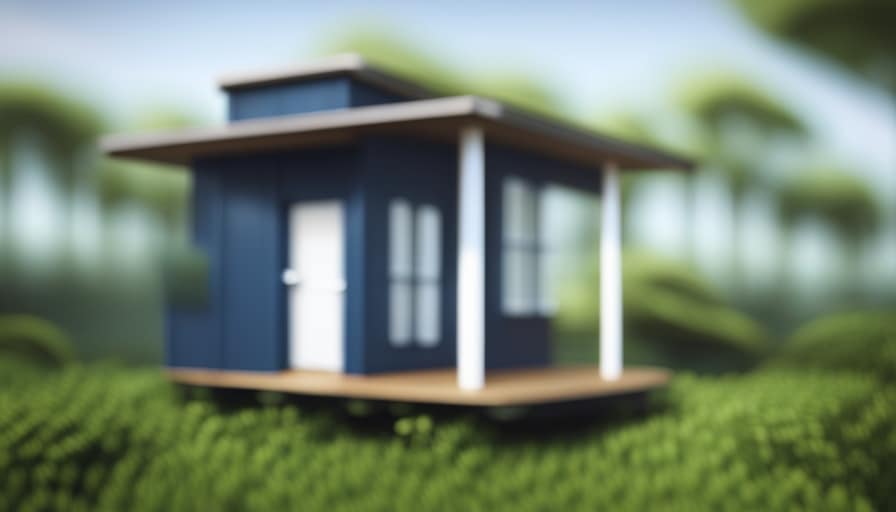
I’m Theodore, and I love tiny houses. In fact, I’m the author of Tiny House 43, a book about tiny houses that are also tree houses. I think they’re magical places where imaginations can run wild and adventures are just waiting to happen.
While tree houses are often associated with childhood, they can be the perfect adult retreat. They offer a cozy space to relax and unwind, surrounded by nature. And since they’re typically built on stilts or raised platforms, they offer stunning views that traditional homes simply can’t match.
If you’re looking for a unique and romantic getaway, a tree house tiny house might just be the perfect option.
-

 Beginners Guides3 weeks ago
Beginners Guides3 weeks agoHow To Buy A Tesla Tiny House
-

 Energy Efficiency2 months ago
Energy Efficiency2 months agoBest Tiny Homes For Cold Climates
-

 Beginners Guides2 weeks ago
Beginners Guides2 weeks agoTiny House Nation Where Are They Now Stephanie
-

 Tiny House Resources (e.g., legalities, cost, insurance, FAQs)2 months ago
Tiny House Resources (e.g., legalities, cost, insurance, FAQs)2 months agoDo Tiny Homes Need Planning Permission?
-

 Beginners Guides3 weeks ago
Beginners Guides3 weeks agoFrom The Show Tiny House Nation How Many Keep Their Tiny House?
-

 Beginners Guides2 months ago
Beginners Guides2 months agoUsing a Climbing Net For Treehouse Construction
-

 Beginners Guides2 months ago
Beginners Guides2 months agoHow to Build a Treehouse Without Drilling Into the Tree
-
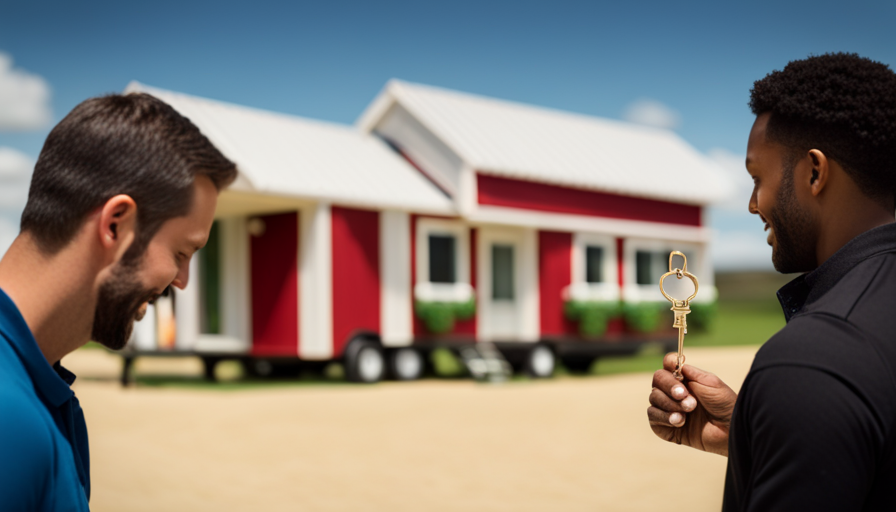
 Beginners Guides4 weeks ago
Beginners Guides4 weeks agoTiny House Nation Who Pays For The Houses







